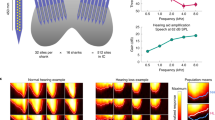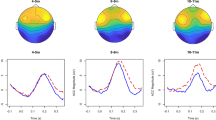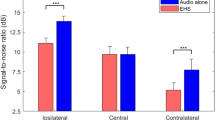Abstract
Profoundly deaf people, who gain no benefit from conventional hearing aids, can receive speech cues by direct electrical stimulation of the cochlear nerve1,2. This is achieved by an electronic device, a cochlear implant, which is surgically inserted into the ear. Here we show physiological results from the isolated sciatic nerve of the toad Xenopus laevis, used to predict the response of the human cochlear nerve to vowels coded by a cochlear implant. These results suggest that standard analogue cochlear implants do not evoke the patterns of neural excitation that are normally associated with acoustic stimulation. Adding noise to the stimulus, however, enhanced distinguishing features of the vowel encoded by the fine time structure of neural discharges. On the basis of these results, and those concerning stochastic resonance3–5, we advocate a cochlear implant coding strategy in which noise is deliberately added to cochlear implant signals.
This is a preview of subscription content, access via your institution
Access options
Subscribe to this journal
Receive 12 print issues and online access
$209.00 per year
only $17.42 per issue
Buy this article
- Purchase on Springer Link
- Instant access to full article PDF
Prices may be subject to local taxes which are calculated during checkout
Similar content being viewed by others
References
Bilger, R.C. et al. Evaluation of subjects presently fitted with implanted auditory prostheses. Ann. Otol. Rhinol. Laryngol. 86, suppl. 38, 1–176 (1977).
Tyler, R.S., Moore, B.C.J. & Kuk, F.K. Performance of some of the better cochlear-implant patients. J. Speech Hear. Res. 32, 887–911 (1989).
Wiesenfeld, K. & Moss, F. Stochastic resonance and the benefits of noise: from ice ages to crayfish and SQUIDs. Nature 373, 33–36 (1995).
Moss, F. & Pei, X. Neurons in parallel. Nature 376, 211–212 (1995).
Collins, J.J., Chow, C.C. & Imhoff, T.T. Stochastic resonance without tuning. Nature 376, 236–238 (1995).
Evans, E.F. Place and time coding of frequency in the peripheral auditory system: Some physiological pros and cons. Audiology 17, 369–420 (1978).
Kiang, N.Y.S., Moxon, E.C. & Levine, R.A. Auditory nerve activity in cats with normal and abnormal cochleae. in Sensorineural Hearing Loss (eds. Wolstenholme, G.E.W. & Knight, J.) 241–273 (Churchill, London, 1970).
Evans, E.F. The frequency response and other properties of single fibres in the guinea pig cochlear nerve. J. Physiol. (Lond.) 226, 263–287 (1972).
Kiang, N.Y.S., Watanabe, T., Thomas, E.G. & Clark, L.F. Discharge Patterns of Single Fibres in the Cat's Auditory Nerve. (M.I.T. Press, Cambridge, Massachusetts, 1965).
Knauth, M., Hartmann, R. & Klinke, R. Discharge pattern in the auditory nerve evoked by vowel stimuli: A comparison between acoustical and electrical stimulation. Hear. Res. 74, 247–258 (1994).
Clopton, B.M. & Glass, I. Unit responses at cochlear nucleus to electrical stimulation through a cochlear prosthesis. Hear. Res. 14, 1–11 (1984).
Frankenhaeuser, B. & Huxley, A.F. The action potential in the myelinated nerve fibre of Xenopus laevis as computed on the basis of voltage clamp data. J. Physiol. (Lond.) 171, 302–315 (1964).
Roper, J. & Schwarz, J.R. Heterogeneous distribution of fast and slow potassium channels in myelinated rat nerve fibres. J. Physiol. (Lond.) 416, 93–110 (1989).
Dubois, J.M. Evidence for the existence of three types of potassium channels in the frog Ranvier node membrane. J. Physiol. (Lond.) 318, 297–316 (1981).
Schwarz, J.R., Reid, G. & Bostock, H. Action potentials and membrane currents in human node of Ranvier. Pflugers Arch. 430, 283–292 (1995).
Bretag, A.H. & Stämpfli, R. Differences in action potentials and accommodation of sensory and motor myelinated nerve fibres as computed on the basis of voltage clamp data. Pflügers Arch. 354, 257–271 (1975).
Hill, A.V., Katz, B. & Solandt, D.Y. Nerve excitation by alternating current. Proc. R. Soc. Lond. B 121, 74–133 (1936).
Kiang, N.Y.S. & Moxon, E.G. Physiological considerations in artificial stimulation of the inner ear. Ann. Otol. Rhinol. Laryngol. 81, 714–730 (1972).
Shannon, R.V. Multichannel electrical stimulation of the auditory nerve in man. I. Basic psychophysics. Hear. Res. 11, 157–189 (1983).
Goldberg, J.M. & Brownell, W.E. Discharge characteristics of neurons in the anteroventral and dorsal cochlear nucleus of cat. Brain Res. 64, 35–54 (1973).
Young, E.D. & Sachs, M.B. Representation of steady-state vowels in the temporal aspects of the discharge patterns of populations of auditory-nerve fibres. J. Acoust. Soc. Am. 66, 1381–1403 (1979).
Delgutte, B. & Kiang, N.Y.S. Speech coding in the auditory nerve. I. Vowel-like sounds. J. Acoust. Soc. Am. 75, 866–878 (1984).
Wilson, B.S. et al. Present status and future enhancements of the UCSF cochlear prosthesis. in Cochlear Implant: Current Situation (ed. Banfai, P.) 395–427 (Rudolf Bermann, Erkeleng, 1988).
Parkin, J.L. & Stewart, B.E. Multichannel cochlear implantation: Utah design. Laryngoscope 98, 262–265 (1988).
Simmons, F.B. Electrical stimulation of the auditory nerve in man. Arch. Otolaryngol. 84, 2–54 (1966).
Spoendlin, H. & Schrott, A. Analysis of the human auditory nerve. Hear. Res. 43, 25–38 (1989).
Erlanger, J. & Gasser, H.S. Electrical Signs of Nervous Activity. (Univ. Philadelphia Press, Philadelphia, 1937).
Rushton, W.A.H. A theory of the effects of fibre diameter in medullated nerve. J. Physiol. (Lond.) 115, 101–122 (1951).
Douglass, J.K., Wilkens, L., Pantazelou, E. & Moss, F. Noise enhancement of the information transfer in crayfish mechanoreceptors by stochastic resonance. Nature 365, 337–340 (1993).
Levin, J.E. & Miller, J.P. Broadband neural coding in the cricket cereal sensory system enhanced by stochastic resonance. Nature 380, 165–168 (1996).
Gingl, Z., Kiss, L.B. & Moss, F. Non-dynamical stochastic resonance: Theory and experiments with white and arbitrary coloured noise. Europhys. Lett. 29, 191–196 (1995).
Benzi, R., Sultera, S. & Vulpiani, A. The mechanism of stochastic resonance. J. Phys. A Math. Gen. 14, L453–L457 (1981).
Fauve, S. & Heslot, F. Stochastic resonance in a bistable system. Phys. Lett. 97A, 5–7 (1983).
McNamara, B., Wiesenfeld, K. & Roy, R. Observation of stochastic resonance in ring laser. Phys. Rev. Lett. 60, 2626–2629 (1988).
Dodge, F.A. & Frankenhaeuser, B. Membrane currents in the isolated frog nerve fibre under voltage clamp conditions. J. Physiol. (Lond.) 143, 76–90 (1958).
Klatt, D.H. Software for a cascade/parallel formant synthesizer. J. Acoust. Soc. Am. 67, 971–995 (1980).
Author information
Authors and Affiliations
Rights and permissions
About this article
Cite this article
Morse, R., Evans, E. Enhancement of vowel coding for cochlear implants by addition of noise. Nat Med 2, 928–932 (1996). https://doi.org/10.1038/nm0896-928
Received:
Accepted:
Issue Date:
DOI: https://doi.org/10.1038/nm0896-928
This article is cited by
-
Stimulator compensation and generation of Gaussian noise stimuli with defined amplitude spectra for studying input–output relations of sensory systems
Journal of Comparative Physiology A (2023)
-
A structured ICA-based process for removing auditory evoked potentials
Scientific Reports (2022)
-
Stochastic Resonance in Insulator-Metal-Transition Systems
Scientific Reports (2020)
-
Inconsistent effects of stochastic resonance on human auditory processing
Scientific Reports (2020)
-
Augmenting Global Coherence in EEG Signals with Binaural or Monaural Noises
Brain Topography (2020)



